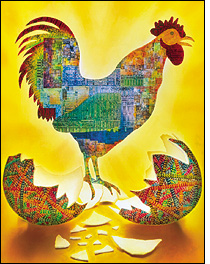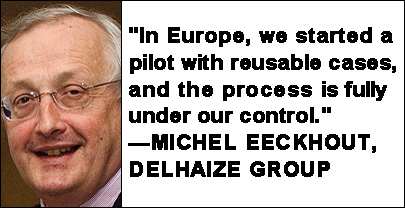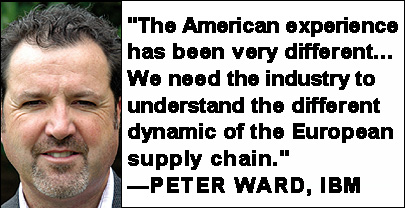Earlier this year, Ahold, the international supermarket and food-service giant, initiated two RFID pilots to track goods moving through the company’s supply chains—one in the United States and one in Europe. The goal of both pilots was to use Electronic Product Code technology in the ultrahigh-frequency spectrum to track food and other goods shipped to distribution centers and then on to retail stores. But that’s where the similarities ended. Ahold found that the road to EPC adoption in Europe was much more difficult—though not impossible—to navigate.
In the United States, where Ahold operates the Giant Food and Stop & Shop supermarkets, the RFID pilot got under way within eight months from concept. But in Europe, where Ahold operates the Albert Heijn stores in the Netherlands and the ICA supermarkets in Scandinavia—among other retail chains—the pilot took 16 months to deploy due to a lack of available Gen 2 RFID tags and interrogators.
Another bump in the road was the limited radio frequency spectrum for UHF RFID use in Europe, which posed a challenge to Ahold’s goal of operating numerous interrogators at once at its distribution centers, each of which has up to 80 dock doors. There was no such problem in the U.S. pilot, where regulations enable companies to operate dense-reader environments.
Ahold isn’t the only European retail giant to succumb to technical difficulties. Two of Europe’s highest-profile RFID trials—those involving Metro AG in Germany and Tesco in the United Kingdom—have fallen behind schedule or have had to switch gears. Because of this, other retailers throughout Europe have been waiting on the sidelines to see the results of these much-publicized tests. Only recently have some begun testing the waters, including Belgium’s Delhaize Group, which owns 2,500 supermarkets worldwide, and France’s Carrefour Group, which owns 7,000 hypermarkets, supermarkets and convenience stores, mostly in Europe.
“It’s a little slower than I was expecting,” says David Weatherby, EPCglobal‘s European adoption program manager. “If you look at some of the things Tesco or Metro said a year or so ago, they’re not as far as they were hoping to be.”
Metro’s plan to track EPC-tagged cases has been pushed back until the end of 2006. The company has recently switched from Gen 1 to Gen 2 EPC technology, after numerous delays in obtaining the Gen 2 hardware (see “Metro Is Back on Track”).
Tesco’s supply-chain trial, which started in October 2003 (the retailer announced plans to deploy RFID in its 1,400 stores and 30 distribution centers in the United Kingdom by the end of 2005), has been extended to only 40 stores and one distribution center. Tesco’s chief technology officer John Clarke told attendees at the 2005 RFID Journal LIVE! conference that European retailers were encountering far more challenges in deploying RFID in their supply chains than their U.S. counterparts. “It appears to me, as a non-U.S. person, that here it’s all ready, let’s go do it and have fun,” said Clarke, “whilst the European space is a very challenging environment.”
But while European retailers have had to delay testing and/or deploying EPC technology in the supply chain, they have not been deterred. They are snapping up Gen 2 technology as it becomes available for new pilots. They are pushing government leaders for access to additional bandwidth within the UHF spectrum. And they are forecasting business benefits from RFID in terms of keeping store shelves stocked with the right goods, complying with new food and pharmaceutical tracking laws, tracking the reusable assets used to transport goods from distribution centers to stores, and automating the paperwork involved in shipping and receiving.
Still, the very nature of the European Union poses unique challenges to the deployment of RFID in the supply chain. Manufacturers often utilize different packaging, in different languages, adhering to different regulations for the same products destined for different European countries. To solve these problems, the European Union is taking steps to establish standards for the global supply chain (see “Come Together”).
The Technology Gap
Companies on both sides of the Atlantic have been eagerly awaiting Gen 2 EPC technology. In the United States, manufacturers and retailers are looking forward to getting improved read rates on pallets and cases of goods. But in Europe, Gen 2 technology is essential to deploying the technology in the supply chain. The first-generation UHF EPC tags were developed in the United States and optimized to perform well in the 902 MHz to 928 MHz band used in that country. Consequently, they didn’t work as well in the 869.4 MHz to 869.65 MHz band initially dedicated to UHF RFID in Europe.
In addition, European regulations on UHF interrogators impeded performance. Power limits restricted interrogators to half a watt of effective radiated power (ERP), which meant UHF tags could be read from no more than about a meter away (3 feet) compared with the readings at 10 to 12 feet (3 to 4 meters) in the United States, where interrogators could use 4 watts of power. Now, power levels in Europe stand at 2 watts ERP, so UHF tags can be read from at least 90 percent of the distances achievable in the United States.

“There’s been a technology gap,” says Stephen Proud, European RFID lead partner for Accenture. “Europe has historically had regulatory restrictions on higher bandwidth. Gen 1 technology didn’t take that into account. Gen 2 has been designed with European and U.S. interests, to provide the best reader performance in terms of read rates.”
But Gen 2 technology has been slow to reach the companies that arguably need it the most. Many RFID vendors have concentrated their efforts on supplying U.S. companies that need to meet tagging mandates from retailers such as Wal-Mart and Target. Tesco and Metro did not issue similar mandates. Instead, the European retailers worked out arrangements with some key suppliers to start RFID-tagging shipments. More than 50 percent of EPCglobal’s members are from the United States, with Europe only slightly ahead of Asia in terms of memberships.
Procter & Gamble (P&G), which has been tagging pallets of diapers, detergents and paper goods for Metro since November 2004, expected to be shipping more tagged goods to Metro by now. “When Gen 2 was announced, we were all starting up with Gen 1. Once everyone saw new technology coming, nobody wanted to invest anymore,” says Dirk Heyman, director of Auto-ID Europe for Gillette, which is part of P&G. “It’s certainly something that has been a hindering factor for all of the industry.”
Gillette is now preparing to tag cases of goods destined for Metro. “People here really want this to work,” Heyman says. “A lot of technology groundwork is being done here, before people are really willing to go all out.” That includes improving the accuracy of readings and making sure the software is in place to gather the information from RFID readings and use the data internally.
Regulatory Woes
The limited spectrum available for UHF RFID in Europe will pose problems for Ahold and other companies that want to operate more than 10 interrogators at a time in a warehouse environment. In Europe, where additional UHF spectrum bandwidth was allocated for UHF RFID use in 2004, there are only 10 channels available in the 865.6 MHz to 867.6 MHz range, whereas in the United States, regulators have allocated 50 channels in the 902 MHz to 928 MHz range.
Ahold moved forward with its European pilot, because it’s smaller in scale than a full-fledged implementation and doesn’t involve using interrogators at 80 dock doors at once. “We did not overcome it,” says Erwin Veer, Ahold’s global RFID manager. But, he adds, the company has experimented with the issue and “there are bandages that we can use to help,” including turning on interrogators only when they need to be on and separating the channels.
One reason Europe has such limited spectrum available for UHF RFID is that the European Union is made up of different countries with different national laws and different uses of spectrum. Also, other industries in Europe, such as the GSM mobile-phone industry, claimed some of the spectrum years ago. RFID is a latecomer, says John Falck, chairman of the group that represents the RFID industry in the European Telecommunications Standards Institute (ETSI), which oversees radio spectrum standards in the European Union (EU).
“We [in Europe] now have regulations that allow us to drive over a country road,” says Veer. “In the U.S., regulations allow you to drive over a 10-lane highway….With one reader, there is no issue. But as soon as you scale up, it becomes more difficult.”
Europe has made tremendous strides in paving the way for the use of UHF technology throughout the supply chain. Only a few years ago, several European Union countries were using the band of UHF spectrum for various military and broadcasting purposes. Today, through the work of ETSI, nearly all of the 15 core European Union countries have agreed to make the UHF spectrum available for RFID; France has agreed to do this by the end of the year, and Spain has until 2007. (Italy still needs to clarify its commitment, officials say.)
“The allocation of spectrum, and making it available for use in the different countries in Europe, has been a long and hard process,” says Falck. “But I would say that the availability of spectrum for RFID in Europe is actually not that different from the Middle and Far East. North America has been spoiled by having a full 26 MHz of bandwidth in which to play. It’s the only country in the world in such a position.”
But even with commitments throughout Europe to make the UHF band of spectrum available and increase power levels, the meager amount of spectrum available will not be enough to support widespread deployment of RFID technology in the future. While the European RFID industry grabs what it can right now, it’s setting in motion a process to convince the European Commission to consider future spectrum needs over the next 10 or 15 years.
The regulatory problems in Europe are not necessarily deterring pilots. “I would be careful of suggesting that this regulatory situation is stopping or disabling the rollout of RFID,” says Henri Barthel, technical director of EPCglobal. Still, he believes major retailing organizations that are looking ahead and trying to figure out how to deploy RFID throughout the supply chain see the regulations as obstacles.
Anticipating Benefits
European retailers and suppliers are working to overcome the technical and regulatory obstacles because they are convinced there are benefits to RFID adoption in the supply chain. Some of the benefits are the same as those that U.S. companies are seeking, such as reducing out-of-stocks and shrinkage. But Europe’s supply chain is already fairly efficient, because stores and distribution centers don’t have the space to store huge inventories. European retailers typically receive frequent deliveries of pallets with mixed goods—for example, a supplier might send detergents in the same pallet as diapers and toilet paper—and that mix of goods has to be precisely what the store needs. Ahold, for example, expects the U.S. pilot will produce greater improvements than the one in Europe.
One area where RFID could have a strong impact on the European supply chain is tracking goods as they flow across country borders, changing hands between numerous logistics and transportation companies. But cooperation among all parties is essential.

“The diversification in Europe is higher,” says Florian Michahelles, associate director of the Auto-ID Labs at the University of St. Gallen in Switzerland. “They must cooperate with a number of logistics providers, which imposes organizational challenges. Everyone has to be willing to participate.”
European companies believe RFID can deliver other benefits because of their way of doing business. In Europe, goods tend to be shipped and received in returnable transport items (RTIs) instead of the disposable cases and pallets common in North America. RTIs range from roll cages and dollies, which can move cases of goods, to reusable cases and totes, used to transport fresh foods or pharmaceuticals. Roll cages are often wheeled off the back of a truck right into the aisles of a store to unload goods.
Tagging RTIs could help a company solve two problems at once: tracking shipments through the supply chain, and realizing a return on investment by tracking the assets themselves. “The thing with RTIs is it involves two business cases,” says Ahold’s Veer. “One is in the supply chain, which is the same as tagging cartons and boxes. With RTIs you combine that with the asset management business case, and suddenly you have two ROI baskets instead of one.”
RFID also holds promise for helping retailers comply with new European laws requiring the traceability of food and medicines. Belgium’s Delhaize Group started two RFID pilots this year—one in the United States and one in Europe. Both seek to track and trace the receipt and shipment of meat at the distribution-center level. They were prompted, in part, by concern about terrorist attacks on the food supply and by recent scares involving mad cow disease.
The U.S. pilot involves the use of disposable RFID tags on pallets of meat—but only from suppliers that are already tagging pallets of meat. The European pilot involves tagging reusable cases that carry the meat. Delhaize tags the RTIs, which gives the supermarket company greater influence over the pilot.
“In Europe, we started a pilot with reusable cases, and the process is fully under our control,” says Michel Eeckhout, Delhaize’s vice president and chief information officer. “That is the reason why the pilots in Europe are generally done in the internal supply chain, as at Tesco and Marks and Spencer. We can convert 100 percent of the goods to the pilot, controlling the whole process.”
Another goal for European retailers is to build an infrastructure to automate the entire paperwork process involved in shipping and receiving goods. In the future, advance shipping notices may be sent electronically to retailers from a supplier, instead of being sent on paper. “Many of the retailers I see are building the basic infrastructure,” says Gillette’s Heyman. “They’re building from the ground up. Instead of saying, ‘Let’s tag some goods,’ some are starting with the software and hardware so that they can track electronically.”
One such company that has been focused on automating the process is the German food retailer Rewe, which started testing RFID in its supply chain earlier this year. Rewe is using EPC technology to track shipments of mostly dry foods from about 30 suppliers to a distribution center near Hamburg. “Mainly they want to improve the process efficiency and tracking,” says Klaus Vogell, head of RFID sales and marketing for GS1 Germany. Rewe is interested in having “a quicker process and good data quality.”
Toward Better Understanding
Because of Europe’s unique supply chain, Peter Ward, IBM solutions leader in Europe, believes there’s a strong drive for select item-level RFID projects. “Business benefits in the European supply chain around pallet and case adoption have not been so easy to identify and qualify,” says Ward. “Logistics and warehouse managers do not see business returns being achieved by RFID at the case level.”
European retailers also are more interested in rolling out EPC technology on a category basis than on a geographical basis, as in the United States, says EPCglobal’s Weatherby. In Europe, it makes more sense to look at individual categories, such as fresh food products with a short shelf life. This strategy is partly driven by the fact that there are no retailer mandates as in the United States.
Ward says that RFID hardware and software vendors need to look at European requirements and make Gen 2 products available. “The American experience has been very different for a variety of reasons,” Ward says. “We need the industry to understand the different dynamic of the European supply chain. A lot of people misjudged where we would get a benefit from RFID in the network.”
European leaders have recently committed to helping industry find the return on investment for UHF RFID in the European supply chain. In July, the European Union pledged €7.5 million ($9.5 million) in funding for a three-year initiative dedicated to the research, development, training and demonstration of the effective use of RFID systems. The funding will focus primarily on systems based on EPCglobal standards.
IBM expects that 2007 will be a year of extended RFID pilots in areas such as pharmaceuticals, manufacturing and consumer packaged goods, says Ward. Once European business leaders better understand where they will see business value from RFID based on pilots and implementations—not just on the word of consultants and vendors—Ward expects an “explosion in RFID projects across Europe from late 2007 and into 2008 and beyond.”
Come Together: Europe Seeks to Forge an RFID Policy
Business and government leaders in Europe fear that if each of the European Union’s 25 national member states adopts its own regulations governing the use of the ultrahigh-frequency spectrum, it would put the brakes on RFID use in the supply chain. To develop an integrated and consistent policy toward RFID, the European Commission—the EU’s executive body—is in the midst of a five-month process, expected to wrap up in mid-September, to gather and analyze information about RFID across Europe. The commission will draft proposed policies on issues—including spectrum and frequencies, privacy, and Europe’s role in standards development and interoperability—which should be available in October.
“RFID is not a topic that has gained much consensus,” says Gerald Santucci, head of the European Commission’s unit dealing with RFID. “We have the opponents and we have the proponents. If I may use some jargon, we have the ‘yes tags’ and the ‘no tags’ people. The challenge is to find a point of equilibrium.”
In addition to conducting a series of workshops, the commission opened an online site to gather public opinion. In the first week, more than 1,000 responses were submitted. The initial response has been “very well balanced,” says Santucci, but it has raised concerns that the commission may need to address, such as using RFID in the workplace to track employees. Europe has laws that require employers to inform and obtain consent before employees can be monitored or tracked, and Santucci says the commission may have to make sure the public is aware of them.
At the same time, the commission will likely delve into the question of whether greater consumer protections need to be in place before RFID is deployed widely in stores and the supply chain. Europe has some of the world’s strongest regulations protecting the use of personal data gathered on citizens by companies. “In Europe, we believe that the current framework on privacy can apply perfectly to RFID and, therefore, there is no need for more legislation,” says Elizabeth Board, executive director of EPCglobal’s public policy steering committee.
While those laws will clearly apply to information gathered through RFID use, they may need to be tweaked. “More work needs to be made on the interpretation of what personal data is,” says Santucci. “Some people are saying that their socks or their shoes are also a matter of personal data. It is their ownership.”
The proceedings have already helped outline three principles that will likely appear in the policy framework: The commission should focus on RFID applications, not the technologies; privacy and security need to be built in at the design stage; and everything must be done to maximize individual participation and consent.
In addition, officials are now convinced that standards and interoperability must be addressed on a global level and that Europe needs to play a greater role. “Not only do we have to find a consensus for today but also for the longer term,” Santucci says. “RFID, as it is today, is very much still in the laboratory…More and more, RFID will pervade the whole economy and the whole society.”
Illustrations by Joe Baker.





